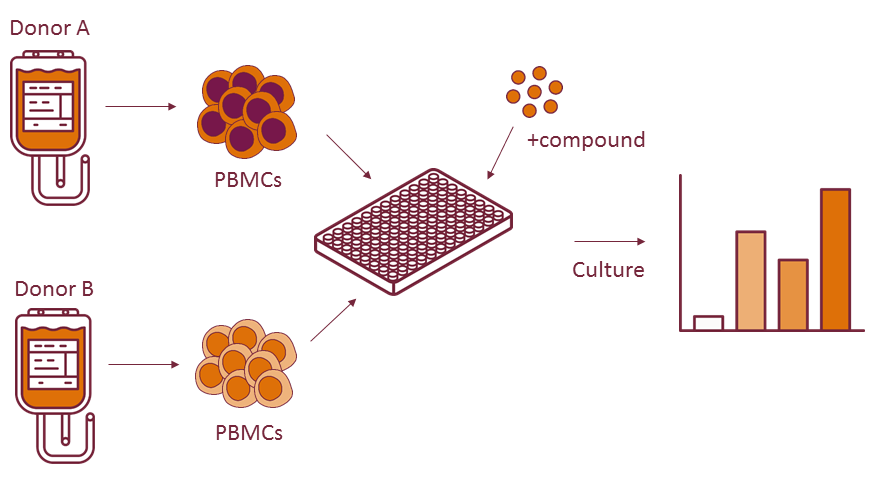
Mixed lymphocyte reaction
Test your immunomodulatory drug by measuring effects on T cell proliferation in a mixed lymphocyte reaction (MLR).
The MLR is based on an allogeneic immune reaction that occurs when lymphocytes of two different donors are co-cultured, resulting in T cell activation. As a read-out for this activation, proliferation and/or cytokine production is analyzed several days after start of culture. The effects of your immunomodulatory drug on T cell activation induced by antigen presenting cells can be determined with an MLR.
Depending on your research question, the MLRs can be performed with total PBMCs, in which case T cells from both donors will be activated (two-way MLR). Alternatively, the assay can be performed with monocyte-derived dendritic cells from Donor A in combination with isolated T cells from Donor B (one-way MLR). Furthermore, we can either repeatedly use the same donor pairs, or test numerous different donor pairs.
 In the above example, PBMCs of two donors are mixed 1:1 and cultured in the presence and absence of the compound(s) of interest.
In the above example, PBMCs of two donors are mixed 1:1 and cultured in the presence and absence of the compound(s) of interest.
Advantages of MLR
- Rapid setup
- Customizable
Example of a mixed lymphocyte reaction (MLR)
Comparison of the effect of 3 biosimilars on T cell proliferation via 3H thymidine incorporation after an MLR
 Here, the effect of low and high doses of 3 different biosimilars (A, B and C) on T cell proliferation were assessed. PBMCs from two healthy donors were co-cultured in an MLR. T cell proliferation was measured by the high-troughput method of 3H thymidine incorporation.
Here, the effect of low and high doses of 3 different biosimilars (A, B and C) on T cell proliferation were assessed. PBMCs from two healthy donors were co-cultured in an MLR. T cell proliferation was measured by the high-troughput method of 3H thymidine incorporation.
Read-out options
The effects of an MLR can be determined via several different read-outs.

